Rev., Dec 3-4-5-6, 2021.
A dream tableaux demands certain elements. Previous visions by Nerval in Aurelia are tableaux, having a strange meteorological event, then comparing that to a setting below, and then a talus or dream structure in the form of a building. A talus is an architectural machine created by the imagination to in dream capture the essence of the dream. Thus, the inn or country house on the edge of a high cliff, like in Moonraker (1958), or the rooftop walks in Dracula has Risen from the Grave (1967). If Nerval had advanced to an “epigogic” state of consciousness, he experienced a tingle and a sense of freezing, still; then, the world would have flipped on him, for all of this life to look very far away from him. By that rearrangement of vectoring, however, he might experience ophthchthony, seeing through the darkness to the truth. He might have got there in the book. But, then, alas, under the Blue Sun of death, a deadfall formed against him, he felt shut out from life, maybe all that was needed was that mummy, to push him. Perhaps there was a few city service devices in the narrow street that lead down to the river. Maybe this path atop the world of REM was paved with faced-down demon plates, to ward off the evil that comes up on it out of the river. At the river’s edge was not just river, but a municipal sewer structure with three levels of outlet, no doubt a 19th century devisement to handle excess run off in times of heavy rain flooding.

the main offflow was likely the opening on the left, but then, at a slightly higher level, another outlet, fed through the wall of a structure. Perhaps Nerval had done the measurements, and knew that this sturdy iron bar sewer mouth was just high enough over the lower level that it offered with steps to reach it and then a drop to take him the perfect way to both tie himself up and drop down, hanged man, in suicide. This is so devised, it seems preplanned. Indeed, Dore, by all but propping up Nerval’s body as if it is almost still standing, might be commenting on the precision of his plan, but also that he also arranged it so that it did not seem like a great step to the beyond. Maybe Nerval wanted to hang himself but feared the gibbetted way of hanging. It is suggested that there is a prognostic plan here, for him to leave this life on his own two feet, to walk on to his afterlife.
But, then, as happens with spiritualists who gain the clear-seeing level, his good spirit leaves his body, this pictures the moment he slumps away, it has a down-pass up-pass element of mesmerism, and depictions of the departure of the spirit from the body as if by ricochet or bounce is typical of mesmeric theory spirit photos. This again places him at the clear-seeing level.
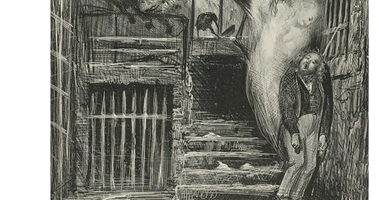
but, then, up top, at the end of the public passage, the rattling nature of the locale is personified by the death skeleton, blowing a horn.
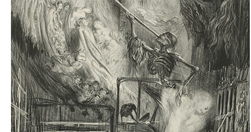
Perhaps there was an urban legend that death hung about at the end of these creepy passages to the Seine. Dore is saying Nerval was drawn by death there. But, then, finally, as if to direct the eye of the viewer away from even trying to visualize all the dead of the Seine, Dore has his spirit backtrack over the dead and enter the world of spirit as imagined by mesmerists and spiritualists that throngs about high over the avenues of Paris.
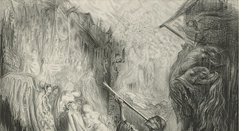
way up
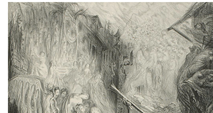
On the right, hell, evil spirits, on the left, heaven, and a cascade on a stairway to heaven over the avenue beyond. It is, that is, very much like the visions Nerval had in Aurelia, and thus Dore might have thought that in this sort of rendering of the suicide he was committing Nerval back to his imagined world. But as a record of level of consciousness, he places Nerval at the level of the clear-seer, with cosmic consciousness.
This view shows the site in more detail, not unlike the stairs made use of in Joker (2020), it seems that it was all but viewed as a machine for suicide.
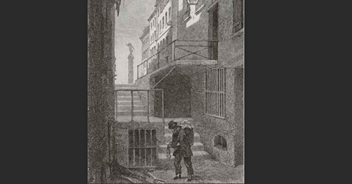
To summarize. overall, Nerval was tasked to build an “I” against his mental illness or schizophrenia, using his imagination. It would appear that he was succeeding. Except, as I analyze it, the dream forms made use of in Aurelia are repeatedly spun involutely over themselves for the whole spin to then get carried away, leading to a nightmare crash. In his crashes, he then had frightening visions of the destruction of Paris. These trigger full nightmare crashes, with suicide ideation, which frequently rears its ugly head in the book. He seemed to think that his manic euphoric escapisms offered him a way out of mental illness. He was perhaps enchanted by mysticism (I do not believe he was, in fact, a mystic), and then magnetism made great claims for a spurious capacity in humans. But the record of his visions shows a quickly accelerating recursive spin of increasingly excessive claims that seem to reach a euphoria but also have in fact cannibalized the glory and lead to a crash and yet more suicide ideation. It is that spin, the Night Mirror, the Morning Storm, and then some, that is reflected in his drawings. In this one of Catharine de Medici the signature which Prinzhorn identified as characteristic of schizophrenia appears to be there, a second one a working out of his family tree
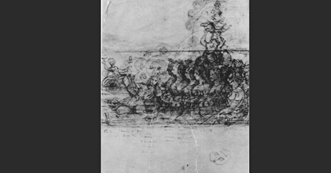
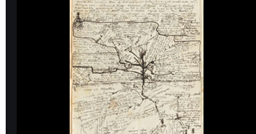
As to Nerval’s death, pictorial evidence seems to suggest the end of his life influenced how people saw the whole of his life. While academic writers writing about artists or poets who committed suicide might be chagrined at this tendency of popular thought, it is a trope, and hard to stop. It certainly seems like it worked its way into the Nerval cult.
This started, as I was saying, with Dore’s picture. Then it spread.
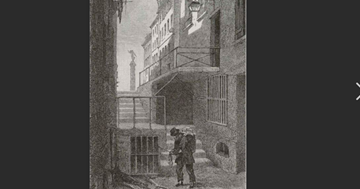
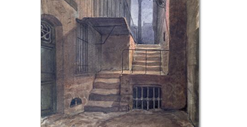

The site preyed upon the minds of people, then, because of its psychogeography. The above print shows the whole terrain. Out at the end is a column, indicating avenue life. But, then, it is but one or two short blocks, at that point, to the Seine, but you have to walk down one flight of steps to a service entrance or door that serves the buildings there. Atop that door is a platform that leads into an apartment, or factory. Then, there is a rail, and another shorter step down. There is a large sewer opening below, and it seems that what looks like a barred window on the right is also a sewer outlet, for floods in times of overflow. All of this then flowed over a lower platform presumably at the level of the river. This riverside locale, of course, can be found in a hundred places in the writings of the time, and in movies about that time since. For me, it has all the markings of a typical “place of sacrifice”, as recorded in dreams. It almost graphs out as a fear vector, from the POV of its descent to the river.
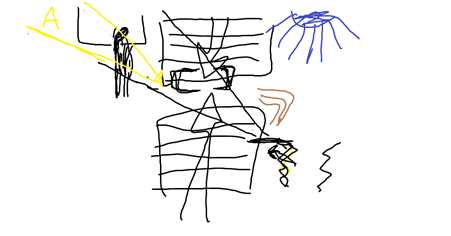
That is, high up, in “everyday life” is the monument, and, beyond that, in Dore’s imagination, heaven, angels. Above, though, there is the approach from avenue to cul de sac, to a dead end, to the first level, not the most attractive of streets, but serviceable. But, then, between that upper dark opening, and the lower dark opening, the mind as if tip toes down from vigilogogy into hypnagogy, and it is right at this point, this strange nexus, that there is the hook or detail that somehow Nerval noticed, knew about, or mused over, that here were two levels of sewer outlets, but for that, you could stand on the upper level, tie a tope to the bars of that opening, then jump, and end up a few feet still off the lower level. It was all but made, like the guillotine, to be a suicide machine. That where-is-this is a deadfall formation, that makes of the place below it the neighborhood Tarpeiian rock, the place of sacrifice, the river itself the zone of monsters. Thus, then, the whole zig zag, the two levels, the stairs, playing off the motif of haunted stairs, then the odd twist, it is a place of sacrifice. And seen off to the side of, or down from the normal of, it is a talus, dream formation, evoking creepiness.
And, indeed, it seems that some artists grasped this, it was almost as if the suicide machine bespoke some aspect of his soul, as in this montage picture of his mind
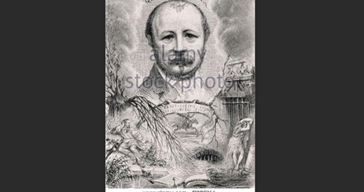
with the sewer grate being almost his empty heart, and the scene the vagus nerve in his neck, connecting heart and head, or something like that
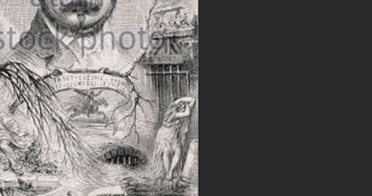
and this is where Marcousis, of the various illustrators of the book, comes into it. I recently posted: “Somehow I stumbled on Gerard de Nerval’s Aurelia (1853) and joined the debate, mystic or schizophrenic? After deconstructing Dore’s enshrinement of his strange-choice-of-place suicide, January 26, 1853, a victory of good soul over demons, taking place in a dead end of Old Lantern street into sewer outlets into the Seine, I found that Louis Marcoussis in the 1930s abstracted the setting’s stairs into a motif that he then backbuilt like in a reverie over all the scenes of the story. At one point Nerval ran to Place de Concorde to jump into the Seine in front of a crowd but when he saw the sun become a black sun and it all go pitch black he ran off, to warn people of the end of the world. Soon after Nerval ran up the Rue St Honore toward the Louvre but had a dizzy tilt that made him see several moons racing over the palace and then it all tilt on its side as in the moment he felt the earth lurch out of its orbit to catapult unhinged into deep space, as he tried to hang on. Marcoussis also captures his search for Aurelia’s tomb, the idea that the whole book was all a dream and finally where Nerval made a pact with the Elohim about an occult truth armed with the knowledge of which he felt he had defeated his demons. Legend says the mss of Aurelia was found in his coat pocket, when they were taking the body down. Very, very interesting readings by Marcoussis, musing”.
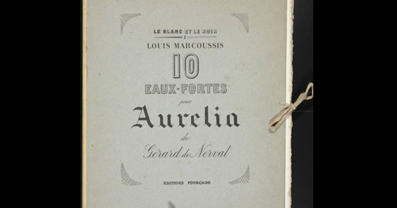
The fascinating thing about Marcoussis’s etchings is that he obviously started with Dore’s image of Nerval suicide
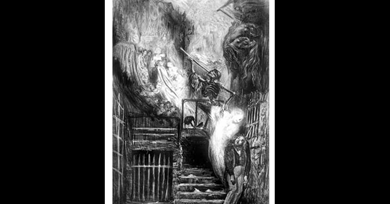
then abstracted it.
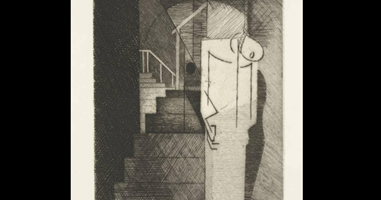
right in front of the body, as if blocking it out in another zone, death, is the lowest flight of stairs. Then the platform which afforded him this novel suicide locale is hidden behind him. He then as if leaves a gap in one’s perception, making it unclear how the upper, light-tinted steps, relate to the lower steps, that represents the in-between, the Luor, the step over the gap, which means this is entirely happening either side of the in-between in the Land of Nod. And then further back, like in Dore, he trails off back up to normal life, the busy world of the everyday. My guess is that Nerval is abstracted into a ghost to represent rather his suicide ideation than his actual body after suicide (kind of grossly, but weirdly half standing, represented by Dore). That is, a conjecture that Nerval knew the spot, and knew, therefore, where to go to get an easy painless suicide (this then functioning for Nerval like the empty room with a noose and chair in it in the Seventh Victim (1945), indeed, there is some support culturally for lore of the idea that one way to value life more is to lock in place a suicide pact that will make you appreciate every day more).
But, there is more. I said above that it looks like Marcoussis’s conception for the whole suite of ten prints was to make of it a reverie, that is, fixating on a motif, or trope, and then multiplying that form through the whole rest of it. In this case, if it was known that Nerval died at the foot of stairs leading down to the river, then, the effect of the suite is to, in fact, take his suicide moment, and backbuild it over the whole of Aurelia, to make all of it an expression of the fact that the book was written by a suicide, and his whole life is to be viewed in light of that suicide, even leading to that suicide.
In the Insane Asylum, where a good deal of the book takes place, the stairs dominate, in a composition that echoes the former
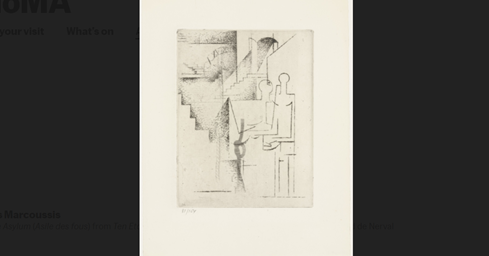
indeed, it looks like proto-suicidal; Nerval is having trouble with some of the inmates, which he describes, and that the chamber or cell he is in, echoing on his place of death, is claustrophobic. But here too there is a stairway up and out, and, after a platform, which might be an avatar of himself reading, there is a zag from a zig out to the world at large. Thus, compositionally, it says his asylum periods primed him for suicide.
In the Tomb of Aurelia, the stairs become the passage from life to death and vice versa. She is pictured entombed in a crypt. But he is pictured as a shadow in the negative space of the architecture, not unlike in the movie The Night House (2021), an “illustration” of related scenes in the story because in fact Nerval was lead randomly to the cemetery after he followed a cortege, but then forgot where Aurelia’s tomb was, so had to run back to his place to get the note which told him where, that involving, then, a frantic up and down of the stairs, and out, but then he still did not visit it. So, the illustration bespeaks the negative space of that manic episode.
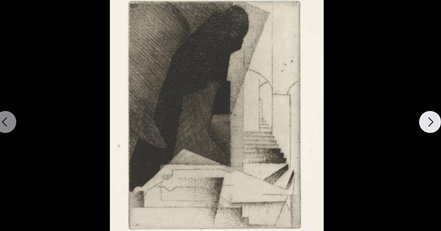
And stairs are in The Garden
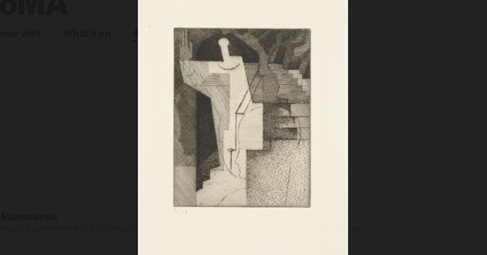
there are also stairs in what looks to me like the central print of the suite, Place de Concorde and even in Several Moons
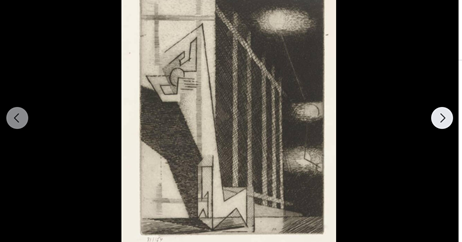
all in all, without arguing it further, it can be said that what Marcoussis did to create an atmosphere of death and doom was build off of the suicide images, and then build back.
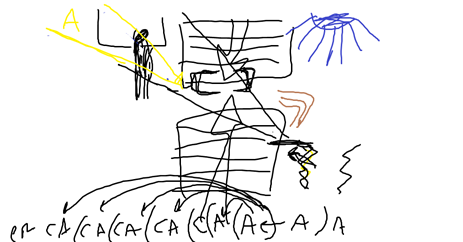
this as if rebuilds Paris in the mind of the reader of this illustrated version of Aurelia as the necropolis of Gerard Nerval, and the place where his tomb was, and it was all a tomb to him. This repeated backbuild is retrogressive, to emphasis the cult aspect of his death, and to further make of him a cult figure. Given that living Paris cannot, really, imagine what it was like to live in dead Paris, it also precludes any imaginative identification with the dead, he is dead, he died a suicide. But, of course, this retro wheel spinning runs counter to the what I contend is the Night Mirror mind-spinning of Nerval’s mind, the spinning which built up houses of cards, for them to then, upon first touch of pressure, all come tumbling down.
There is one more point, on how this can work, poetically. That stairs is the space between, and the space between must itself be granted full agency, as an entity unto itself.
I argue then that when Marcoussis read Aurelia and about Nerval he felt that the stairs of the suicide legend picture proved that Nerval was moving in outer inner space. It is in this transitional space, this trap space, this transitional element, that dream is cultured and conjured. Marcoussis seemed to grasp this. I know this is a real mindspace because as noted previously one reason why Nerval’s Aurelia, and its aftermath events, intrigue me, is that I suffered phthses very much like any one of his described episodes, in my 20s. The most famous was in a small hotel room in Florence, 1979. I realized I had reached the apogee of my wandering (I had run out of money), after a year wandering, it was time to go home. My mind crashed. I do not think I slept, but I must have because in a “dream” the door to the tiny closet in my room opened up. It was an abstract in-between space, in person in my dream, it connected, by a passage in the back corner of it, to the de Medici passage, and by crawlspacing through into the passage I found a way to compensate for my loss of hope and a sense of seeing it all by roaming alone through the Uffizi taking in all the art into me at night. The glory of that “experience” only made my present situation worse. It strikes me that the dream created a hyperloop spin which, just like in the case of Nerval’s episode of making art in Aurelia, caused the house of cards to periacqueductally spin and dissolve and lose all power and as a fixed-on thing in the lattice crash in a whoosh down to splat. It is the abstraction that opened the door, but also shut me down.
I am going to give Marcoussis points then for understanding an element of dreaming that it is apparent Nerval did not quite understand. He did not see that, if he had visited this site earlier, scouting it out as a suicide site by his river of death, the Seine, he felt the in-itself prototype antiquity of it, and knew, this was a good place to die at. That then bespoke to him, in a kind of insight which might be linked to clairvoyance, as a good way to depict dream Paris, which, again, for Nerval was Paris come BACK to from the dreamland of the pagan Rhine. His dream Paris, that is, he did not see, was lethal.
It does seem, from this print, that Marcoussis believed in the mystic aspect of the story, and that Nerval was, by his reading, a mystic. I am less convinced. Nonetheless, if he did, this is a statement that Nerval like the Seeress had arrived at stage five clear-seeing, cosmic consciousness (which is also the level at which Walt Whitman sought to write, see American hieroglyphs).
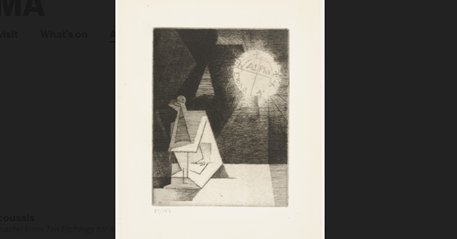
there is perhaps in the print a too close relationship to this famous Rembrandt, but note that Marcoussis has Nerval sitting beside and below, in the shadow, as if shrugging, like durer’s Melancholic angel. Again, my reading is that these manic spins dematerialized his house of cards, causing a crash
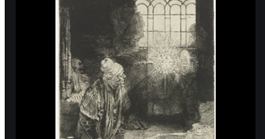
So, what makes this dream-based art, versus something else, is that Marcoussis made the interesting decision that the whole physical set up of the dead end where Nerval’s suicide took place was a perfect example of a deep structure or nature morte almost bespeaking the strife of the suicide itself, without the figures, and as such he converted it into a talus formation which forms in dream in the symbolic level as it drifts out into ambience, and, framed by a peripteral wall, to become phantom, the whole complex is fixed on
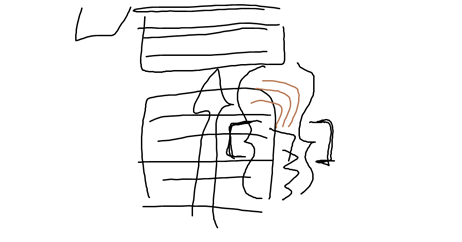
and then, from that fixing, can be backbuilt back through every scene in the story.
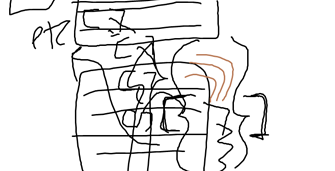
it is, ultimately, a thanatoptic view of Paris, and of Nerval’s life but it then wends its way back over the prescribed pathway of the life as marked out in the book, and by that retrogressive overcast creates as if a dream of his life, if not angelspace, then Nervalspace. Indeed, Marcoussis pinging on the abstract chords of memory in the Palace de Concorde, with the black sun, is not that different from my appreciation of the abstraction world space of the Palais Royal, the Daniel Buren piece (see my article, 1991) there plucking on invisible ley lines of memory, to make it all tremble.
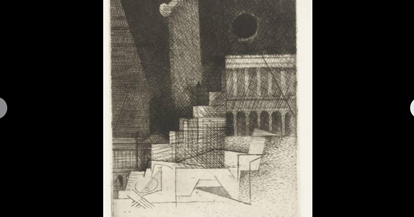
the one scenic element, the building on the right, is converted back into an extended form of the dead end spot, by causing the monument in the middle of the square to re-form as a stairway which places the scene inside the trace of Nerval’s experience on the devil’s road. And then the pattern reproduces itself in the pattern of the cobblestone, and Nerval’s state of phthsis, or near death, is conveyed by him also being cast to the bottom of those stairs, and laid out splat on the pavement, or almost of the pavement, and even looking almost like a statue of a reclining nymph you might see at the Louvre, or see Paris through. It is quite effective, if a poetic overcast on the more frenetic description of the event in the book. All in all, then, a solid evocation of the book. All of which means, I think Marcoussis also devised a system of abstract vectors by which to “retell” the scene in each incident, to create his nonetheless suicide-spot overcast images of Nerval’s Aurelia.
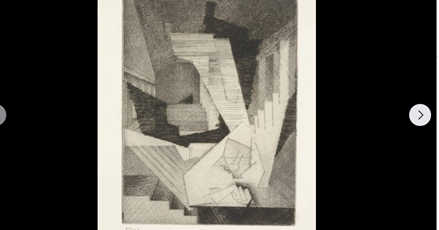
The stairs are clearly the primary vector, and they signify the passage from life to death for him. But there are counter-stairs too, light, and then light vectors that I do not understand, and it is possible there is a vocabulary of a few different sorts of steps here, the stairs of a sewage outlet, the stairs of a street, the stairs of a house, or fire escape, the stairs of a balcony or palace. Indeed, this vocabulary of stairs was notable when the only element in recent art that I can relate to the way in which the Street of the Old Lantern dead end was instrumentalized of late, the staircase in Joker, which was an issue at the time.
These drawings bespeak my sense that Aurelia was written as but also in a dream and its tableaux of Paris were set-pieces of the kind created by dreams and which I call talus formations, in hypnagogy, at the edge of ambience. Marcoussis then pushed the whole story into the second level symbolic level of hypnagogy, as it zig zags to the talus form, maybe even opening up to the half-life form, and he made use of Dore’s print to ground and rethink the entire story as happening inside the maze of a stepped universe whose umwelt form IS the Street of the Old Lantern (and, of course, the search for the umwelt is always done with a lantern, as per Blake’s Jerusalem), making it pure dream, hypnagogic, and all of it of a premonition of those stairs and all figures as a cubistic premonition of the strange half-standing posture that Nerval ended up his life in (an odd death pose not unlike a figure impaled on a gate spike, or caught screaming in a coffin, it is tropaic). Marcousis, an artist I do not know, understood the dynamic, the dream and the nightmare, and as a result rendered drawings of an all but scirpographic intensity in capturing the trapped nature, once upon the onset of trouble, of the last years of Gerard Nerval.